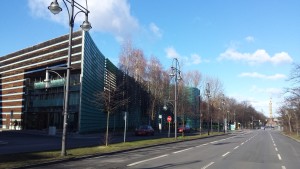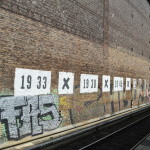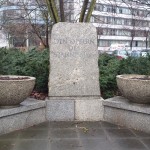Please also read this about the premise of the walks and the sources of information.
Length of walk: Approx. 5.1 km.
Meeting place: Nordische Botschaften/Nordic Embassies: Among other factors, the wish to utilise the prime location on the south side of Tiergarten efficiently, led to the building of the five Nordic Embassies (Denmark, Finland, Iceland, Norway and Sweden) within one space enveloped by a copper wall. Completed in 1999, the complex comprises six individual buildings arranged geographically, all unmistakenly “Nordic” but each with national distinctive features in terms of architecture and materials used. enveloped by a green, copper clad, snaking wall. We will only be able to peek through the fence to see a little bit of the embassies, but the communal building, housing among other functions an auditorium, a canteen and all five consular sections, is open to the public. Read more here: www.arcspace.com/features/berger…/nordic-embassy-complex/.


On our way to Wittenbergplatz, we cross the Landwehrkanal via Corneliusbrücke, originally built in the late 19th century, destroyed during the Second World War, and rebuilt in 1954/55. Stolpersteine: (http://www.stolpersteine-berlin.de/en/stolpersteine). Passing along Bayreutherstrasse where at No 41 a Stolperstein commemorates Alexander Westermayer who lived there from 1939 (the original house was totally destroyed towards the end of WW2). Having been one of the founders of “Bund Deutscher Sozialisten”, he joined a resistance group called “Europäische Union”, in 1943, which advocated the restoration of democratic rights and freedoms and a united, free and socialist Europe. The group strengthened intra-German resistance, while sheltering and feeding people, including Jews, persecuted by the Nazi regime and procured them ID cards. On September 9, 1943 Westermayer was arrested, found guilty of high treason and membership of a “subversive organisation” and sentenced to death by guillotine. The sentence was carried out on 19 June 1944 at 15.12 o’clock.
Also in Bayreutherstrasse, at No 38, a Stolperstein commemorates one Edith Bodek, about whose life nothing is known except she was deported to Auschwitz on 29 November 1942 on the “23rd Berliner Osttransport” together with another 997 people. The date of her death in Auschwitz is unknown.
Wittenbergplatz was laid out between 1889 and 1892. Wittenbergplatz U-Bahn station is one of the oldest U-Bahn stations in Berlin, opened on 11 March 1902, and has a remarkable Art Nouveau entrance hall from 1913, designed by Alfred Grenander (Slow Travel Berlin has more about him here: http://www.slowtravelberlin.com/alfred-grenander-architect-of-the-underground/). Outside the western entrance is a monument erected by League for Human Rights 1967 entitled “Places of Terror We Must Never Forget”.

KaDeWe (Kaufhaus des Westens) probably needs no introduction (but if it does, at least go and visit the delicatessen floor – a sight in itself). Brief history: Built by the then famous architect Emil Schaudt, it opened in 1907 with an area of 24,000 sq-m, and is today the largest department store in Continental Europe with 60.000 sq-m. During WW2, allied bombing ruined it, with one American bomber actually shot down and crashing into it in 1943. First two floors re-opening in 1950, full reconstruction finished in 1956. Between 1976 and 1978, the store’s floor space was expanded from 24,000 sq-m to 44,000 sq-m. Just after the fall of the Berlin Wall in 1989, KaDeWe recorded a record-breaking number of people going through the store. Berlin – the “broken-chain sculpture”: From here, looking up Tauentzinstrasse, we also get a glimpse of this familiar sculpture: http://en.wikipedia.org/wiki/Berlin_(sculpture),
and the Europa-Center, which was built in 1965 as the first modern shopping centre: http://en.wikipedia.org/wiki/Europa-Center. Olof-Palme-Platz, since 1991 named after the Swedish social-democratic Prime Minister who was assassinated in 1986 – a crime that has never really been solved. Elefantentor: Passing the main entrance to Berlin Zoo with the elephant gate, originally from 1899, destroyed during WW2, and rebuilt true to the original, in 1984. Elephants in sandstone, red wooden pagoda.
Bikini: In contrast to KaDeWe, the latest shopping centre, or rather “concept mall” – “Bikini” – was opened in late 2013. It is a reconstruction of an existing building from the 1950s, and the original architecture, visible on the façade, is combined with modern utilisation and energy concepts. There is a freely accessible 7000 m² green rooftop terrace on top with a view over the monkey enclosure in the Zoo.
Passing Kaiser Wilhelm-Gedächtniskirche, www.gedaechtniskirche-berlin.de, (after the TV tower probably the most famous of Berlin’s sights, known to the berliners as the lipstick & powder puff, the original church on the site was built in the 1890s. It was badly damaged in a bombing raid in 1943. The present building, which consists of a church with an attached foyer and a separate belfry with an attached chapel, was built between 1959 and 1963. The damaged spire of the old church has been retained and its ground floor has been made into a memorial hall.
Moving on into Kantstrasse, we pass Theater des Westens built in 1896 in a mixture of Jugenstil and Neobaroque, affectionately called the sugarbowl, the Delphi Filmpalast, and the “Kant-Dreieck” with one of the first “skyscrapers” in Berlin, built by Josef Paul Kleihues, it is 56 m tall and has a huge shark-fin shaped aluminium weather vane on top, turning in the wind like a giant sail. http://openbuildings.com/buildings/the-kant-dreieck-profile-2028.
Bonus info from one of the participants in the walk: The building was built 1992-95 as one of the first new office buildings in the west of the city, designed by Josef Paul Kleihues whose trademark it is to always incorporate steel nails in each tile on the façade. To the right on Fasanenstrasse, another architecturally interesting building is multi-purpose communication centre, The Ludwig-Erhard-Haus http://www.willebrand.com/project450.html can be seen (but we are not going past it).
Paris Bar, Kantstrasse 152, used to be THE insider place for artists, actors and media people and boasts visitors from Gorbatjov to Madonna. It is often very busy but it is worth taking a look inside.
Savignyplatz: The allegedly originaly completely symmetrical Savignyplatz was laid out in 1861, and the S-Bahnhof opened in 1896. The bronze sculptures from 1921 on the north side are by August Kraus.
On the south side a kiosk designed by Alfred Grenander – remember – he of the entrance hall of the Wittenbergplatz U-Bahn station?
On the platform of the S-Bahn station there is a recent mural by Ben Wagin – “Weltbaum II” with environmental messages.
The painter George Grosz (1893-1959) http://en.wikipedia.org/wiki/George_Grosz lived in Savignyplatz 5. Known especially for his caricatural drawings of Berlin life in the 1920s, he was a prominent member of the Berlin Dada and New Objectivity group during the Weimar Republic before he emigrated to the United States in 1933.
We are on the edge of what is known as Berlin’s Chinatown, with a higher concentration of Chinese and Asian restaurants, shops and supermarkets than anywhere else in Berlin, on and around Kantstrasse between Savignyplatz and Wilmersdorfer Strasse (this part of Kantstrasse is therefore also affectionately called Kantonstrasse). The first Chinese immigrants came to Berlin in the beginning of the 20th century to study at Technischen Hochschule Charlottenburg or Hochschule für Politik. The first Chinese restaurant opened in 1923 in Kantstrasse 130b. In this area, we would also find the former Charlottenburg prison for women, which is now rented out to various art projects.
Pestalozzistrasse Synagogue: But we are going up Grolmanstrasse and left on Pestalozzistrasse to No 14/15 and the synagogue, recently re-inaugurated after a major renovation. Outside the building, two clusters of no less than 19 and 21 Stolpersteine respectively, have been laid down. More information can be found here: http://www.stolpersteine-berlin.de/en/stolpersteine. It turned out that only a sign on the wall revealed that it is a synagogue.
The first we (from the InterNations.org Berlin’s Landmarks group) did this walk, we stopped for coffee and cakes in Café Hardenberg – for me a very nice discovery.
Coming into the home stretch, we go past Steinplatz from 1885, with memorials for the victims of the Nationalsozialismus and Stalinism, and Hotel am Steinplatz, built in Jugendstil by August Endell.
The walk was scheduled to finish at Berlin Zoologischer Garten Station, aka Bahnhof Zoo. The station building overlooks the Hardenbergplatz square, named after Prussian prime minister Karl August von Hardenberg (1750–1822), Berlin’s largest city bus terminal and night bus service centre, and also used by long-distance buses/coaches. The original station opened on 7 February 1882. On 11 March 1902 the first Berlin U-Bahn line, today the U2, was opened under ground. During the cold war, Bahnhof Zoo remained the only long-distance train station within West Berlin. On 28 August 1961, two weeks after the erection of the Berlin Wall, the new U-Bahn Line 9 was opened below the U2, connecting the station with the transportation network in the north-south direction. The fact that with only two platforms and four tracks for long-distance trains the station was still the most important in West Berlin was another unnatural phenomenon of the divided city. After reunification, despite the outcry from nearby Kurfürstendamm retailers and local politicians, the station dramatically lost its importance following the launch of the new Berlin Hauptbahnhof on 28 May 2006, with long-distance services now passing through the station without stopping. Until 2013 the exception was the famous Sibirjak departing from Bahnhof Zoo for the Novosibirsk Trans-Siberian railway station. But a few stalwarts went back to the Bikini mall to see the roof terrace overlooking the monkey enclosures in the Berlin Zoo. Then on to Monkey Bar on top of the adjacent hotel.
Had the walk taken place during any other season than mid-winter, another good place to finish off would have been the nearby Schleusenkrug Biergarten www.schleusenkrug.de.































